
What Is College-Bound Math
What Is College-Bound Math
College-bound math refers to the set of mathematical skills and knowledge required for success in college-level mathematics courses. It encompasses various core concepts, advanced topics, and practical applications that prepare students for the challenges they may encounter in higher education. Understanding college-bound math is crucial for aspiring college students, regardless of their intended major, as it builds a solid foundation for problem-solving, critical thinking, and analytical reasoning. In this article, we will explore the key aspects of college-bound math, its significance, and how it is applied in different academic disciplines.
Core Concepts in College-Bound Math
To grasp the essence of college-bound math, let us delve into its core concepts. These concepts are typically covered in high school math curricula and form the fundamental building blocks for further mathematical exploration.
Algebra: A Cornerstone of College-Bound Math
Algebra, often considered the cornerstone of college-bound math, plays a central role in this domain. It deals with the study of mathematical symbols and the rules for manipulating these symbols. Algebra encompasses a wide range of topics, including linear equations, polynomials, and quadratic equations.
Linear equations involve variables raised to the first power and express relationships between variables using straight lines. They are used to solve problems involving proportions, rates of change, and simple linear models. Polynomials, on the other hand, encompass expressions with multiple terms, and they play a vital role in representing various mathematical relationships. Quadratic equations involve variables raised to the second power and can be used to model a variety of real-world phenomena, such as projectile motion or the trajectory of objects.
Mastering algebraic concepts equips students with essential tools for solving complex equations, analyzing mathematical relationships, and representing patterns and functions. These skills are invaluable in various fields, from engineering and physics to computer science and economics.
Geometry: Exploring the World of Shapes and Figures
Geometry is another critical component of college-bound math, exploring the properties and relationships of shapes and figures. It encompasses various branches, but the most common one is Euclidean geometry.
Euclidean geometry deals with fundamental geometric concepts, such as lines, angles, triangles, and circles. Students learn to analyze the properties of shapes, understand the relationships between angles and sides, and apply geometric principles to solve problems. Geometry provides students with spatial reasoning skills, enabling them to visualize and manipulate objects in three dimensions. It has practical applications in fields such as architecture, engineering, and graphic design, where understanding shapes, proportions, and spatial relationships is crucial.
Trigonometry, a subset of geometry, focuses on the relationships between angles and the sides of triangles. It finds applications in fields like physics, engineering, and navigation, where understanding angles, distances, and trigonometric functions is essential. Coordinate geometry combines algebraic and geometric principles to study geometric shapes using coordinates and equations. It is widely used in physics, engineering, and computer graphics to model and analyze shapes and their transformations.
By studying geometry, students develop critical thinking, deductive reasoning, and logical skills. They learn to prove geometric theorems, apply geometric formulas, and visualize abstract concepts, which are valuable assets in a wide range of academic disciplines and professional fields.
Calculus: The Mathematics of Change and Motion
Calculus is an advanced branch of mathematics that builds upon algebra and geometry. It encompasses two primary branches: differentiation and integration. Calculus revolutionized mathematics and opened new frontiers for understanding and modelling change and motion.
Differentiation, the first branch of calculus, involves studying rates of change and slopes of curves. It provides tools for analyzing how quantities change over time or in different contexts. For example, it can be used to determine the speed of a moving object, the growth rate of a population, or the rate at which a chemical reaction occurs.
Integration, the second branch of calculus, deals with finding the area under curves and solving accumulation problems. It enables the calculation of quantities such as total distance travelled, accumulated revenue, or accumulated change in a system over time. Integration has applications in physics, economics, engineering, and many other fields where measuring and analyzing accumulated quantities is necessary.
Calculus is a powerful mathematical tool that allows us to understand the fundamental principles that govern the natural world and various systems. It plays a vital role in fields such as physics, engineering, economics, and computer science, where mathematical modelling, optimization, and understanding change are critical.
Advanced Topics in College-Bound Math
Beyond the core concepts, college-bound math introduces students to more advanced topics, expanding their mathematical repertoire and problem-solving abilities.
Probability and Statistics: Analyzing Data and Making Inferences
Probability and statistics are essential branches of mathematics that provide tools for analyzing data, making predictions, and drawing meaningful conclusions. Probability theory deals with the likelihood of events occurring, while statistics involves collecting, organizing, analyzing, and interpreting data.
In probability theory, students explore concepts such as sample spaces, events, probability distributions, and random variables. They learn how to calculate probabilities, understand the principles of conditional probability, and work with various probability models. Probability theory is fundamental in fields like insurance, finance, and weather prediction, where assessing and managing risk is critical.
Statistics, on the other hand, involves using data to conclude populations, make predictions, and test hypotheses. Students delve into concepts such as descriptive statistics, inferential statistics, hypothesis testing, and regression analysis. They learn techniques for summarizing data, analyzing relationships between variables, and drawing inferences from samples. Statistics is widely used in social sciences, economics, market research, and healthcare to make informed decisions based on data.
Proficiency in probability and statistics enables individuals to make sense of data, evaluate claims, and make informed decisions in various real-world situations. It equips students with essential skills for analyzing complex systems, conducting research, and critically evaluating information.
Discrete Mathematics: Structures and Relationships
Discrete mathematics focuses on mathematical structures and objects that are fundamentally distinct and separate, as opposed to continuous mathematics. It deals with topics that have a finite or countable number of possibilities.
Combinatorics, a branch of discrete mathematics, deals with counting and arranging objects. It explores topics such as permutations, combinations, and the pigeonhole principle. Combinatorics finds applications in computer science, cryptography, and probability, where counting and arranging objects are fundamental.
Graph theory is another branch of discrete mathematics that studies networks and relationships between vertices and edges. It examines the properties of graphs, algorithms for graph traversal, and graph coloring. Graph theory has applications in computer science, transportation networks, social networks, and optimization problems.
Number theory, a branch of discrete mathematics that examines the properties of integers and prime numbers, plays a fundamental role in cryptography, coding theory, and computer science. It investigates topics such as divisibility, prime factorization, modular arithmetic, and the distribution of prime numbers.
Discrete mathematics equips students with problem-solving skills, logical reasoning, and the ability to analyze structures and relationships. It forms the backbone of computer science, where understanding discrete structures and algorithms is essential for designing efficient computer programs and solving complex problems.
Linear Algebra: Transforming Mathematical Spaces
Linear algebra is a branch of mathematics that focuses on vector spaces, linear transformations, and systems of linear equations. It deals with the study of mathematical structures that involve vectors and linear operations.
Students explore concepts such as matrices, determinants, vector spaces, eigenvalues and eigenvectors. They learn how to perform operations on matrices, solve systems of linear equations, and analyze linear transformations. Linear algebra finds applications in fields such as physics, engineering, computer science, and data analysis.
Matrices provide a convenient way to represent and manipulate linear transformations and systems of equations. They are widely used in computer graphics, image processing, and network analysis. Determinants play a crucial role in determining whether a system of linear equations has a unique solution. Vector spaces and linear transformations are essential for understanding geometric transformations and concepts like subspace and span. Eigenvalues and eigenvectors are used to analyze and represent fundamental properties of mathematical objects, such as symmetry and stability.
Linear algebra provides a powerful mathematical framework for solving systems of equations, representing transformations, and understanding the fundamental properties of mathematical objects. It is a fundamental tool in numerous fields where linear relationships and transformations are encountered.
Practical Applications of College-Bound Math
College-bound math extends beyond theoretical concepts and finds practical applications in various academic disciplines and real-world scenarios.
Engineering and Physics: Analyzing and Solving Complex Problems
In the fields of engineering and physics, college-bound math is indispensable for analyzing and solving complex problems. Mechanics, the branch of physics dealing with motion and forces, relies heavily on mathematical models and equations. Engineers and physicists use calculus and differential equations to describe the motion of objects, analyze the forces acting on systems, and design structures that withstand external forces.
Electrical circuits, another domain heavily influenced by college-bound math, require an understanding of circuit theory and the application of mathematical principles to analyze and design electrical systems. Thermodynamics, which deals with the study of energy transformations and heat transfer, relies on mathematical models to describe and predict the behavior of complex systems.
By applying college-bound math concepts, engineers and physicists can solve intricate problems, design efficient systems, and analyze real-world phenomena. The ability to use math effectively in these fields is essential for innovation, technological advancement, and solving the challenges of the modern world.
Computer Science: Algorithms, Data Analysis, and Cryptography
Computer science heavily relies on college-bound math concepts for algorithm design, data analysis, and cryptography. Algorithms and data structures form the backbone of computer programming, and a strong mathematical foundation aids in creating efficient and scalable software solutions. Understanding algorithm complexity and analyzing the efficiency of algorithms requires proficiency in discrete mathematics and probability theory.
Data analysis and machine learning, which are integral to fields such as artificial intelligence and data science, rely on statistical methods and probability theory. Analyzing data, extracting meaningful insights, and making predictions all require a solid understanding of statistical concepts and techniques.
Cryptography, the science of secure communication, employs advanced mathematical techniques to ensure data privacy and integrity. Concepts from number theory, such as prime factorization and modular arithmetic, are used to develop secure encryption and decryption algorithms.
By applying college-bound math concepts, computer scientists can develop innovative algorithms, analyze vast amounts of data, and ensure the security of information systems. Proficiency in math is a valuable asset in computer science, enabling individuals to tackle complex problems and drive technological advancements.
Economics and Finance: Modeling, Optimization, and Game Theory
In economics and finance, college-bound math provides essential tools for decision-making, optimization, and modelling complex systems. Optimization techniques, such as linear programming, help maximize or minimize specific objectives given constraints. For example, they can be used to determine the most cost-effective allocation of resources or the optimal production level that maximizes profits.
Financial models and risk analysis rely on probability theory and statistics to evaluate investment opportunities, assess potential outcomes, and make informed decisions. Understanding probability distributions, correlation analysis, and hypothesis testing is crucial for analyzing financial data and assessing risks.
Game theory, a mathematical framework for analyzing strategic interactions, finds applications in economics, politics, and social sciences. It helps analyze situations where the outcome of an individual’s decision depends on the decisions of others. Game theory is used to model and understand phenomena such as pricing strategies, negotiations, and competition.
By applying college-bound math concepts, economists and finance professionals can analyze complex systems, optimize decision-making processes, and model economic and financial phenomena. Proficiency in math equips individuals with the tools to make informed choices, analyze market trends, and contribute to economic development.
Read Also:
College Bound Math in Higher Education
The importance of college-bound math extends to the realm of higher education, shaping the academic paths and requirements for college-bound students.
Math Requirements for College Admission
Many colleges and universities have math requirements for admission. These requirements may vary depending on the institution and the desired major. Some colleges expect incoming students to have completed specific math courses, such as algebra, geometry, and precalculus. Other institutions may require standardized math tests, like the SAT or ACT, as part of the admissions process. These requirements ensure that students possess the necessary mathematical skills to succeed in college-level courses.
Majors Requiring Strong Math Background
Certain majors and academic programs necessitate a strong math background. Fields such as engineering, physics, computer science, economics, and finance typically have math-intensive curricula. These majors often require students to take advanced math courses, such as calculus, linear algebra, and probability and statistics. A solid understanding of college-bound math is essential for success in these disciplines, as it provides the necessary foundation for understanding complex concepts and solving intricate problems.
Math Support and Tutoring in College
Recognizing the challenges students may face in college-bound math courses, many colleges and universities provide math support services to help students succeed. These services may include tutoring, academic assistance centers, or math labs where students can seek guidance and additional help. Tutors and mentors can provide individualized support, clarify difficult concepts, and guide students through problem-solving strategies. Taking advantage of these math support services can enhance understanding, boost confidence, and improve performance in college-bound math.
Challenges and Tips for Success in College-Bound Math
While college-bound math provides valuable skills, it can also present challenges. Overcoming these challenges and adopting effective study strategies is essential for success.
Overcoming Math Anxiety
Math anxiety is a common challenge many students face when engaging with college-bound math. It is essential to acknowledge and address any anxieties or negative beliefs about math. One approach is to build confidence through practice, gradually tackling more challenging problems, and celebrating small victories. Recognizing that mistakes are part of the learning process and adopting a growth mindset can also help alleviate math anxiety. Seeking support from peers, instructors, or math tutors can provide additional guidance and encouragement.
Effective Study Strategies
Adopting effective study strategies can enhance understanding and retention of college-bound math concepts. Regular practice is key to reinforcing knowledge and developing problem-solving skills. Active engagement with the material, such as explaining concepts in your own words or teaching them to someone else, can deepen understanding. Seeking clarification on challenging topics through textbooks, online tutorials, or discussions with instructors is essential for resolving doubts and mastering difficult concepts. Additionally, solving a variety of practice problems, both within and beyond assigned coursework, can improve problem-solving abilities and provide exposure to different problem-solving approaches.
Seeking Help and Collaboration
When encountering difficulties in college-bound math, it is crucial to seek help and collaborate with peers and instructors. Asking questions in class, attending office hours, or reaching out to tutors or math support services can provide additional insights and perspectives that aid in understanding complex concepts. Exploring online resources, discussion forums, and math communities can also offer alternative explanations and approaches. Collaborating with peers through study groups or forming math clubs can foster a supportive learning environment where students can share insights, discuss challenging problems, and learn from one another.
Conclusion
College-bound math forms the bedrock of mathematical education, equipping students with the necessary skills for success in higher education and beyond. By mastering core concepts, exploring advanced topics, and understanding practical applications, students develop critical thinking, problem-solving, and analytical reasoning abilities. Whether pursuing majors in STEM fields, economics, or other disciplines, a strong foundation in college-bound math provides a solid framework for academic achievement.
Embracing the challenges, seeking support when needed, and adopting effective study strategies can lead to successful outcomes and a lifelong appreciation for the beauty of mathematics. College-bound math opens doors to exciting opportunities in various fields, enabling individuals to make meaningful contributions, solve complex problems, and navigate the ever-evolving landscape of the modern world. So, embrace the adventure of college-bound math, unlock your potential, and embark on a journey of discovery and intellectual growth.






